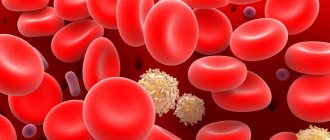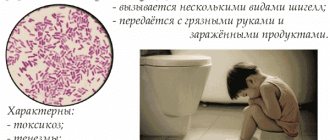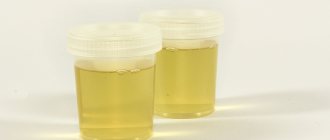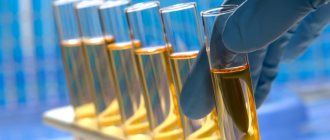Why donate feces to a child?
Parasites very often enter the human body, and fighting them is the main task of doctors in order to maintain human health. Children are especially susceptible to parasites. They run around the streets, play and can often pick up food with dirty hands, or chew their feet, constantly absorbing microorganisms. Therefore, stool samples are always taken from children to check for various parasites.
One of these common ones is the test for enterobiasis. This is a kind of analysis to check for worms. Detection of pinworms is the main method of diagnosing the disease. Very often, an analysis for enterobiasis is carried out when a child experiences the following sensations:
- Constant itching in the anus.
- Restless child's sleep.
- Redness near the anus.
- Excessive attention to the genitals.
In addition to the main suspicions of the presence of pinworms, an analysis for enterobiasis is prescribed if a child enters a kindergarten, school, or swimming pool. An analysis for enterobiasis is also prescribed during the annual examination of the child during inpatient treatment.
A stool sample allows the pediatrician to see the full picture - the state of the child’s gastrointestinal tract and its internal organs. Analysis studies make it possible to show various diseases in the child’s body, as well as tell about his excellent and healthy body.
If the analysis for enterobiasis is correctly interpreted, it is possible to determine the presence of various worms and bacterial infections in a child, and to see a malfunction in the functioning of the child’s internal organs. But for the analysis to be correct, you need to correctly collect stool and store it correctly. Many women are interested in how much stool is required for analysis?
Stool analysis
Feces are the end product of food digestion, which is released into the external environment during the process of defecation. Feces consist of food debris, bile, digestive enzymes, and bacteria (accounting for about 1/3 of the dry residue). Normally, an adult excretes 100–250 g of feces per day, the amount depends, first of all, on the nature of the food consumed and the presence of pathological processes in the body.
To analyze stool, you do not need to collect a full container of material; usually the container is filled to about 1/3 of the volume.
Stool analysis is a laboratory test of stool, which is aimed at detecting various disorders of the gastrointestinal tract in adults and children. The study makes it possible to diagnose pathologies of the digestive tract, helminthic infestations, monitor ongoing treatment, and is also prescribed for preventive purposes.
The normal color of stool is brown, the consistency of the stool should be soft but well-formed, and there are normally no pathological impurities. Single leukocytes can be detected from blood cells in the feces, and only stercobilin from bile pigments. An admixture of blood, pus, mucus, as well as the presence of parasites and/or their eggs indicates a disease.
The main indications for prescribing a particular stool test are pathological conditions: stool disorders (constipation, diarrhea or their alternation), abdominal pain, nausea and vomiting, flatulence, false urge to defecate, weight loss, anemia of unknown etiology.
How to properly collect feces from a child and where to store it
It is much easier for an adult to collect feces than for a child. Collecting feces can be especially problematic for infants. The baby should be placed on a clean oilcloth or diaper and given a light abdominal massage to induce bowel movements. You can turn him over on his tummy and let him lie there for a while.
Pediatricians do not recommend collecting feces from a diaper. But if you can’t collect feces using the above method, then you should collect only the top layer from the diaper, which does not come into contact with the fabric. Many young mothers are interested in how much stool needs to be collected so that there is enough for examination.
A baby cannot collect a lot of feces because it is not known when and how much he will defecate. If you carry out the analysis in the morning, then it is advisable to collect as much as possible in the evening.
In an older child, feces can be taken when he has defecated; it is, of course, advisable to bring “fresh” material to the laboratory. But if you can’t take morning stool, you can take evening stool.
Fecal analysis in infants is normal
The amount of feces in a breastfed baby is 50 grams per day. Artificial dogs poop less, their daily norm is 40 grams. The amount may vary depending on how much the child eats. When eating porridge, vegetables and fruits, the amount of feces increases significantly. A child may have frequent bowel movements due to intestinal malabsorption, cholecystitis, cholelithiasis, diarrhea, pancreatitis and other reasons.
A stool test in an infant is normal. The consistency of stool in breastfed children is viscous and sticky, similar to porridge. In artificial people, the feces look like putty. Dense stool occurs with stenosis or spasm of the colon. With increased intestinal motility and fermentative dyspepsia, the feces are mushy.
Types of stool analysis
The child's body is very often exposed to various diseases due to its weak immunity. Therefore, pediatricians are often prescribed various tests. In addition to the usual urine test, parents also have to collect the child’s feces. There are several types of this analysis.
- Bacterial analysis - the purpose of the analysis is to detect pathogens of intestinal infections. This analysis allows you to detect such infections in the child’s body as dysentery, cholera, salmonellosis, typhus.
- Microscopic analysis - the purpose of the analysis is to identify helminths, intestinal pathogens, various infections - E. coli, bifidobacteria. Basically, it is taken to identify dysbacteriosis in a child.
- Feces for occult blood - to determine and identify hidden bleeding in the digestive tract.
- Feces for enterobiasis - submitted to detect pinworms.
It is important to remember that any of the above tests must be taken in the morning. Therefore, it is best to collect material early in the morning, before leaving for the laboratory. But if you can’t collect it in the morning, then you need to store it in the refrigerator for as long as it takes for a specific analysis.
There is no need to store it for more than a certain period of time, otherwise it will no longer be suitable. Therefore, it is always worth taking it in the morning.
And how much material is required also depends on the type of analysis. Each analysis has its own specific amount, but on average we can say that you need to collect up to 15 milliliters of feces.
Storage and transportation of analysis
The most suitable for analysis is morning feces, but with infants this rule is extremely difficult to follow. The feces collected the day before can be stored in the refrigerator or other cool place for 10-12 hours in a tightly closed container.
The test tube cannot be stored in the freezer.
To transport the collected material, in hot weather you can use a cold pack, or you can wrap the container in several layers of food foil.
Some analyzes involve submitting the most “fresh” material possible. For example, to identify helminths such as Giardia, feces are donated warm. To identify pinworms, collect the remains of feces from the folds of the butt immediately after the bowel movement.
21 Sep 2020 admin 18700
Share this post
- Related Posts
- White plaque in the baby’s mouth – causes and treatment
- Green poop on baby
- Why does a baby spit up like a fountain?
- Diathesis in infants: causes and treatment
Analysis transcript
Decoding the analysis is of interest to every mother. After all, this speaks about the baby’s health, and why not worry? And no matter how many times a child is tested, this question arises every time. After all, a deviation from normal indicators indicates a child’s illness.
If the stool was collected correctly, for example, let’s take ideally - it was collected in the morning, the parents came to take it at a certain time, then its normal indicators will be as follows:
| Indicators | Decoding |
| – Mucus detection. | No. |
| – Detection of blood. | No. |
| – Reaction to protein. | Negative. |
| – Reaction to bilirubin. | Negative. |
| – Reaction to stercobilin. | Positive. |
Rules for collecting stool for analysis
As a rule, many mothers, upon waking up in the morning, collect their children's feces from the diaper into a matchbox, put it in a bag and carry it with them until the opportunity arises to take the feces to the laboratory. However, the results of such an analysis will be unsatisfactory. So how to properly collect feces?
Firstly, under no circumstances should you warm your baby’s tummy in any way, for example, with a heating pad.
And secondly, do not give your baby any medications.
Before going to bed, prepare equipment with which you will collect feces. It must be disinfected, preferably doused with boiling water.
It is best to collect feces in clean, small glass containers, which must also be thoroughly washed.
It is unhygienic to place feces in a plastic bag, paper or matchbox.
Pharmacies sell special plastic containers for collecting tests along with a spoon. After collecting the samples, throw away what you used to collect the stool.
In the morning, it is recommended to collect the stool not from the diaper, but from the diaper. Place a small amount of feces, preferably collected from different places, into a clean jar and close the lid tightly. If you decide to put your baby on the potty and then collect feces from there, then you need to pour boiling water over this container and wipe it dry. Remember that the collected feces should not contain foreign impurities such as water, urine, soap, etc.
How to avoid unreliable analysis?
A number of factors may influence the results of the analysis. These include:
- cleanliness of containers;
- time between collection and delivery of stool to the laboratory;
- storage of material after collection;
- taking medications;
- food eaten the day before;
- foreign matter (for example, urine, water).
To avoid unreliable results, you must adhere to the following recommendations:
- Wash your child on the day of the test with simple baby soap. Some hygiene products contain aggressive components that, if they get into the material for analysis, can disrupt the flora contained in it.
- Use sterile containers.
- Collect stool no later than 6 hours before the test. The most reliable result is obtained if the feces are submitted for examination immediately after collection. However, when this is not possible, you can take it in the evening and leave the container with the material in the refrigerator.
- A week before the test is collected, do not introduce new complementary foods into the baby’s diet. A nursing mother needs to adhere to proper nutrition.
- Do not use rectal suppositories before the examination.
- The day before sampling, avoid taking medications.
In addition to general recommendations, there are features of collecting material:
- material for bacterial culture is collected no later than 2 hours before the start of the study;
- feces for detection of Giardia must be sent to the laboratory immediately after collection;
- 3 days before the occult blood test, foods high in iron should be excluded from the menu.
How to collect a stool sample from a baby
What does preparation include?
Traditionally, obtaining an object for research is carried out at the beginning of the day. Is it possible to collect a stool sample in the evening if this was not possible before? Not advisable, since the rules require samples to be delivered to the laboratory within the first three to four hours. As a last resort, it is necessary to place a carefully closed container of feces in the refrigerator.
In order not to be distracted during the process of directly collecting stool, it is worth taking care of the things you will need in advance. The list looks like this:
- • gas outlet pipe;
- • container or test tube;
- • oilcloth diaper;
- • petroleum jelly.
The container that is required for transporting the material must be cleaned, the oilcloth must be absolutely clean. It is advisable that the mother already has experience in massaging the baby.
How to collect feces from a baby
The task looks difficult only at first glance. It is only important to strictly follow the sequence of actions below.
It’s great if the baby has stable stools that follow a certain schedule. At the appropriate time, remove the diaper and place the baby on the prepared diaper. Next, you just need to wait for the moment when bowel movement occurs.
Proper tummy massage will help set the baby up for the desired action. The palm (pre-heated) is placed on the navel area. Massaging is circular in nature; strong pressure is not allowed. You should move clockwise.
How to collect a stool sample from a baby if the procedure described above does not facilitate bowel movements? Turning the baby onto his stomach often helps. Another method is to pull your legs towards your stomach, while keeping them bent at the knees. The action is performed several times with short breaks; it should be careful and smooth.
What to do if your child is constipated
In most cases, the steps described above will help you obtain the necessary material. How to collect feces from a newborn in the absence of independent stool, in a situation of constipation? A gas tube, which is used to stimulate the anus, will help. Before the manipulation, you need to prepare an oilcloth and place the child on it. There are two position options - on the right side, on the back.
To simplify the task and prevent injury, the tip of the tube is carefully treated with petroleum jelly. The insertion of the device should not be deep - a centimeter maximum, less is better. After this, you need to wait about a couple of minutes, this is enough for the appearance of stool.
In difficult situations, bowel movement may not occur even after manipulation of the gas outlet tube. Then the mother should repeat the massage described above, exercises with tightening the legs. The tube is reinserted approximately half an hour after massaging the tummy.
What else do you need to know
After waiting for the bowel movement, parents can proceed to preparing the material necessary for the study. How to collect a stool sample correctly?
Hand washing is the first action that needs to be taken. Manipulations with the analysis can only be done with clean hands.
The volume of feces that will be the object of study should be about 5-10 g. Therefore, it is enough to prepare a couple of teaspoons.
It is advisable to sterilize the container even before collecting the analysis, paying special attention to this.
The container in which the product is delivered to the laboratory must be signed. It indicates the name and age of the baby. It is imperative to record the time of receipt of the material; this is required for analysis.
What not to do
Many parents make typical mistakes when planning to collect stool from a newborn baby.
Doctors do not recommend priming your baby to have bowel movements using a warm heating pad placed on the tummy. This rule applies to any other warming manipulations.
Drugs that can stimulate stool should not be used. A laxative will make the results incorrect.
Matchboxes, paper, kitchen utensils are the wrong containers for analysis. Ideally, you should purchase a special plastic container, which is sold at any pharmacy. An alternative is a clean, dry jar.
The collection of feces “from diapers” is excluded.
If parents carefully consider all the recommendations given above, the problem will be solved easily.









